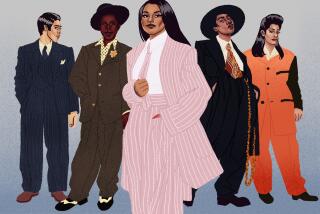The Ties That BInd
In 1904, men in the audience at La Scala in Milan, Italy, showed their admiration for Giacomo Puccini’s new opera by donning “the Butterfly.” Decades later, the white and starched “Bat Wing” paraded by Fred Astaire was as important a celluloid prop as his lacquered nightstick and top hat. And Sir Winston Churchill rallied “an outraged civilization” to war while donning his polka dot silk “Classic” . . . bow tie, of course.
These men’s finery were not the careless, unartful bow ties so prevalent today--pre-knotted and rigid as a windmill’s rotor. They were strips of silk, carefully looped and knotted, adding a well-deserved sense of accomplishment for otherwise idle hands.
It was the bow tie’s bulky predecessor, the cravat (a long and lightly starched piece of material, wrapped several times around the neck and knotted) that required the first hands-on lessons. To aid this process, Stefano Demarelli offered 18th-Century Parisian valets six-hour courses on the subject, for which they paid handsomely. Not until 1827, with the publication in Paris of Baron Emile de L’Empese’s monograph, “The Art of Tying the Cravat,” was the knotting art more broadly disseminated.
Historians believe L’Empese to be the nom de plume of the 19th-Century French novelist Honore de Balzac. His acquisition of mountains of clothing made the rotund novelist worth his weight in debts. He described his philosophy as: “The question of costume is one of enormous importance for those who wish to appear to have what they do not have, because that is often the best way of getting it later on.”
The proof of Balzac’s dictum was evidenced by the financial success of his international bestseller, “The Human Comedy,” which placated his creditors, not with cash, but by listing the addresses of their tie and shirt-making shops on the booklet’s back pages. This, no doubt, inspired the author’s subsequent monograph: “The Art of Paying Your Debts and Satisfying Your Creditors Without Paying Out a Penny.”
The cravat has evolved considerably since the days when its muslin wrappings could deflect saber blows, to the small, if less protective, bow tie of today. And unlike its heyday at the opening of this century, the bow tie is more likely to be seen at formal occasions than in workaday surroundings. Its decline in everyday use is due in part to the prejudice with which it is viewed by others.
John T. Molly’s book, “Dress for Success,” offers this blunt assessment: “You will not be thought responsible if you wear a bow tie. It is a death knell for anyone selling his services, such as a consultant or lawyer.”
A more unapologetic, if somewhat stiff-necked portrayal, is made in the pages of David Mosconi and Riccardo Villarosa’s book, “Getting Knotted”: “The effect obtained, once the bow is tied, is of a no-nonsense look, the rigid and reliable aspect of a person with little time for fools.”
The editors at Esquire magazine avoid the aesthetic argument altogether, offering the stouthearted bow tie enthusiast this practical advice instead: “The rule of thumb is that once tied, the bow should be as wide as the distance between the corners of your eyes.”
As for tying the bow, the method is far less knotty. Though it may seem pedestrian, it’s as simple as tying a shoe.
Tying the Knot
1. Make sure the left end of the tie is about 1 1/2 inches longer than the other before crossing.
2. Loop shorter end around under longer portion of tie and tighten.
3. Take shorter end of tie, folding it horizontally across the collar.
4. Allow longer end to fall in front of the horizontal piece.
5. Slide overhanging end behind horizontal piece and tuck through knot hidden behind.
6. Even the tie by pulling on the ends and straighten.
More to Read
The biggest entertainment stories
Get our big stories about Hollywood, film, television, music, arts, culture and more right in your inbox as soon as they publish.
You may occasionally receive promotional content from the Los Angeles Times.











